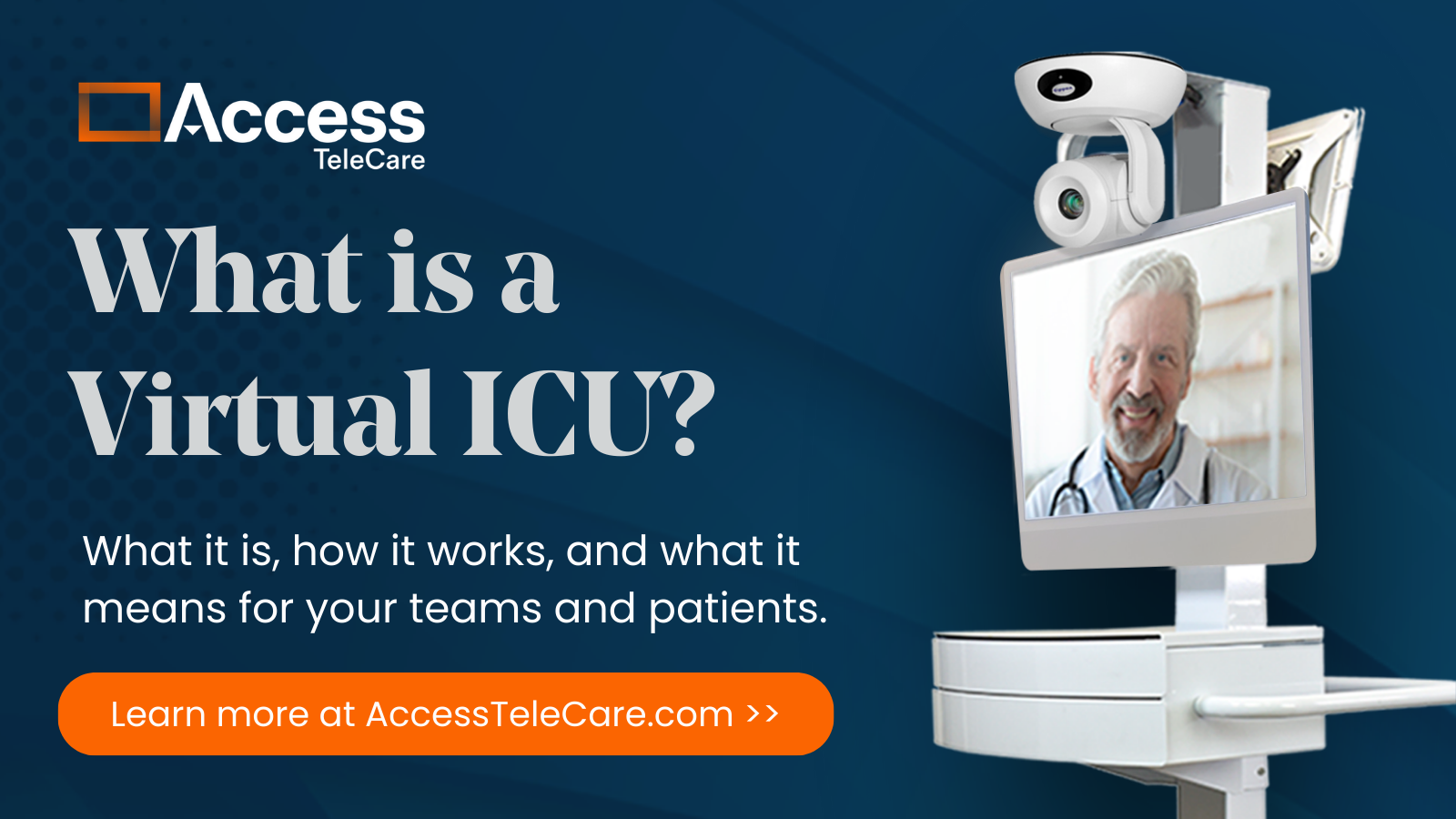ICUs are for the sickest of the sick, who often need dramatic interventions by highly-trained physicians and nurses practicing at the top of their licenses. But, what happens when a hospital doesn’t have enough intensivists to guide patient care? More and more often, with teleICU, critical care physicians are on a video conference with staff and patients, and not physically in the ICU. So, what is teleICU and why do critical care nurses like it? Alyssa Menzenwerth, RN, BSN, is the director operations support at Access TeleCare. She explains the day-to-day operations of Access TeleCare’s teleICU program and answers these questions.
What is teleICU?
TeleICU, also known as eICU, is the diagnosis and treatment of the most critical hospital patients by a remote intensivist using technology similar to videoconferencing. It makes it possible for hospitals to have access to critical care specialists in the ICU, Emergency Room or Med/Surg floors and be connected face-to-face in minutes.
Intensivists, also known as critical care physicians, specialize in unstable and seriously-ill patients with unpredictable medical prognoses. They interact with almost every facet of a hospital. Similar to emergency department physicians and hospitalists, intensivists are an integral component of acute care telemedicine.
How does teleICU work?
TeleICU is very much like a typical ICU workflow―the difference is that the critical care physician is on a video screen. At the beginning of each shift, the teleIntensivist meets with the onsite ICU staff, including the critical care nurses and supervisors. This huddle could include respiratory therapists, pharmacists, hospitalists, etc. Just like in any ICU, each patient’s care is discussed in detail, and care plans are agreed on. The goal is to proactively assess and treat patients before the patient’s condition worsens.
Throughout the day, if an ICU nurse or other clinician has a question about the patient, the teleIntensivist is only a phone call away, just like any other specialist in the hospital. And, in an emergent case, the teleIntensivist can get on camera with the hospital staff and the patient within minutes. And, because the physician is on a telemedicine cart, he or she can be “wheeled” anywhere in the hospital where their expertise is needed, such as the emergency department.
When an emergency occurs in the ICU, the patient care team can request a consult (similar to paging a doctor who may be elsewhere in the hospital.) TeleIntensivists can run codes, talk the care team about procedures, as well as speak directly to patients and/or their families to help with difficult care decisions.
TeleICU is constant bi-directional communication and teamwork. Our Consult Coordination Center helps enable the teamwork and the communication. We really are part of the medical staff, and the ICU staff becomes comfortable with picking up the phone at any time to talk to our physicians, just like they would in their normal workflows.
Menzenwerth and her team work with Access TeleCare’s hospital partners to help implement teleICU and other telemedicine programs, which includes training of onsite staff and remote physicians, as well as analytics and reporting. Building consistency and collaboration into the ICU workflow is important so that the teleIntensivists are integrated into the normal operations of an ICU. Critical care nurses play a large role in successful implementation and adoption of teleICU.
Why do critical care nurses like teleICU?
In an ICU, the majority of hands-on work is done by critical care nurses, even if the intensivist is onsite. These nurses work with patients who require complex assessment and continuous nursing oversight. Most importantly, critical care nurses are patient advocates. About 37% of all nurses who work in hospitals are considered critical care nurses.
The ICU is the heart of the hospital. It is the most challenging nursing environment and critical care nurses want to work with these patients. They thrive on the intellectual aspects of nursing. These care givers don’t want to have to transfer critically-ill patients because they don’t have intensivists on site.
“I worked with a nurse once who told me: I need to go somewhere where my patients are really sick because I need to exercise that knowledge, and I need to exercise that care, and I want to be somewhere where I’m challenged,” says Menzenwerth. “They want to keep the sickest patients but they need the appropriate clinical staff to do so. And teleICU helps them do that.”
At Access TeleCare, the start of shift meetings are called SMARTRounds, which is Access TeleCare’s acronym for Safety Management and Recommended Triage Rounds. This structured collaboration provides an opportunity for both the ICU staff and the teleIntensivist to ask questions and agree on the patient’s care.
SMARTRounds provide a time for the intensivist just to get on screen and talk to the ICU staff. It may start out very formally, but it turns into a conversation, and a learning, and a teaching, and from there that provides an opportunity for the nurses to say, “Wow, I really like the service, I really like these doctors, and I really feel like they can teach me and I’m going to learn from them.”
A common case is a patient who’s been vented for three days. The ICU staff may feel like it’s time to try to wean them off. There’s a variety of ways to do that. For example, taking them off sedation, or conducting spontaneous breathing trials, etc. But, it starts with a conversation about how the patient is doing, and recommendations on how to proceed. It often turns into an educational session for the staff to build their skills, as much as it is to provide care for the patient.
“This interaction builds the confidence for the staff so that next time they want to wean a patient they can say: well, I tried this, this, and this, and it didn’t work. Where do we go from here?” explains Menzenwerth.
What do the hospital physicians think of teleICU?
Hospitalists and other hospital specialists are extremely busy and are constantly on the move. When they are part of the ICU rounding with the teleIntensivist, they can quickly develop a care plan for the patient provider-to-provider. This not only helps build a relationship between them, but it gives both providers a chance to truly sit down and talk about what’s going on with the patient, and discuss treatment plans. The collaboration is extremely helpful to both physicians.
“The hospitalists are busy, they have a lot of people to take care of. Instead of having the hospitalist run in with their phone ringing and their hair on fire, it is beneficial having the teleIntensivist who is only focused on the ICU. They really appreciate having someone that the ICU nurses can call at any time,” explains Menzenwerth.
When an intensivist is available at all hours (or even just overnight), the ICU nurses have the ability to pick up the phone and get someone to address their questions. This helps the hospital physicians focus on their other patients. Having teleICU available overnight helps decrease fatigue and burnout for hospital physicians, as well.
What is your background? How did you get to teleICU?
I always knew healthcare was my calling. I graduated with a B.S. in Biology from Virginia Tech, then joined a rescue squad and became a paramedic to get clinical hours to put on my application to nursing school. After earning my RN, I practiced as an ER nurse throughout Northern Virginia. Craving even more challenge, I also worked as a fixed wing flight nurse part-time for three years, on domestic and international flights.
“I did ER for so long, 18 years of ER nursing, I got a little burned out. I started looking at different ways that I could step back and contribute to nursing from a different perspective,” explains Menzenwerth.
What do you most like about what you do at Access TeleCare?
Menzenwerth is proud of the care Access TeleCare provides. “Our physicians all take the time to sit down if needed with the families, and talk about the care, and talk about the direction they want to go in, and how their loved one is doing. I don’t really think they see the screen as an impediment to having that conversation. They’re so empathetic and able to project that on the screen, and really focus on the family, and do everything that they can for them that it’s like they’re in the room. Patients, families and ICU staff are often very appreciative of the time they spend with them.”
If you would like to learn more about teleICU, please contact us for an overview. You may also want to visit our teleICU webpage.







